To achieve loud yet clean mixes, master proper gain staging by setting levels to prevent clipping early in your signal chain. Monitor peaks closely, keep levels around -6 dB during tracking, and use compression to control dynamics without sacrificing clarity. Balance levels carefully in your DAW, ensuring enough headroom for punch and detail. Using metering tools helps you maintain consistent loudness and avoid distortion. Keep practicing these steps, and you’ll access the secrets to powerful, transparent mixes.
Key Takeaways
- Set input levels around -6 dB to -3 dB during recording for optimal headroom and clarity.
- Use gentle compression to control peaks without squashing dynamics, maintaining punch and transparency.
- Balance faders carefully to establish a cohesive mix, avoiding levels that cause clipping or noise.
- Monitor peak levels constantly, ensuring they stay below 0 dB to prevent distortion.
- Apply final loudness adjustments with limiting to maximize volume while preserving cleanliness and detail.
Understanding the Fundamentals of Gain Staging
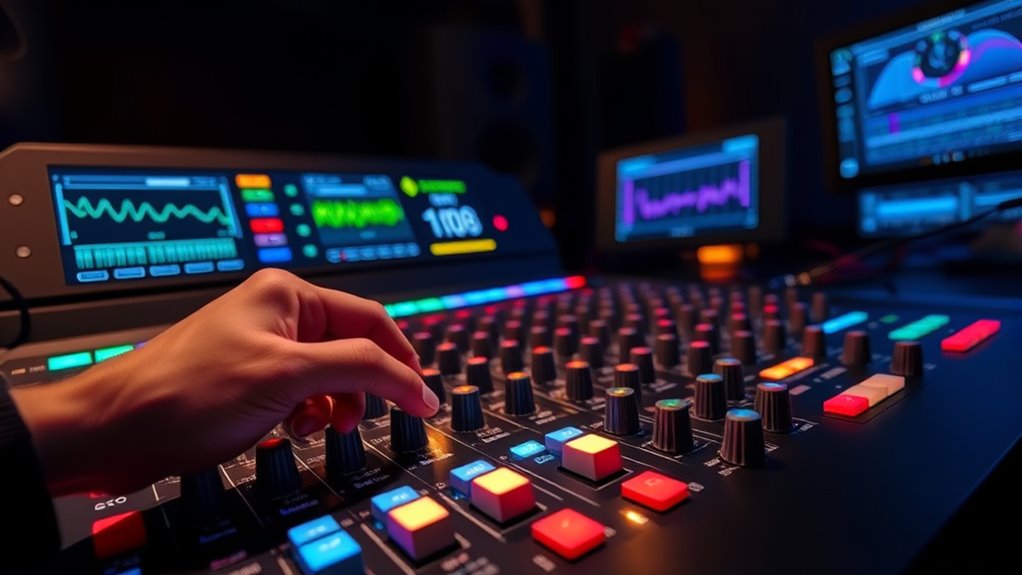
Understanding the fundamentals of gain staging is essential for achieving a clean, balanced mix. It starts with establishing a proper gain structure, ensuring each stage of your audio signal maintains ideal levels. Proper gain staging preserves signal integrity by preventing unwanted distortion and noise, keeping your sound clear and transparent. You want to avoid clipping early in the signal chain, which can cause irreversible damage to your mix. Instead, set your input levels so that each device or plugin receives a healthy, strong signal without overloading. This careful control helps maintain consistency throughout your session. Mastering gain structure allows you to make precise adjustments later, giving your mix a professional polish. Ultimately, understanding gain staging empowers you to achieve loudness without sacrificing clarity. Additionally, understanding audio signal flow is crucial for maintaining proper levels throughout your entire project.
Setting Proper Levels During Recording and Tracking
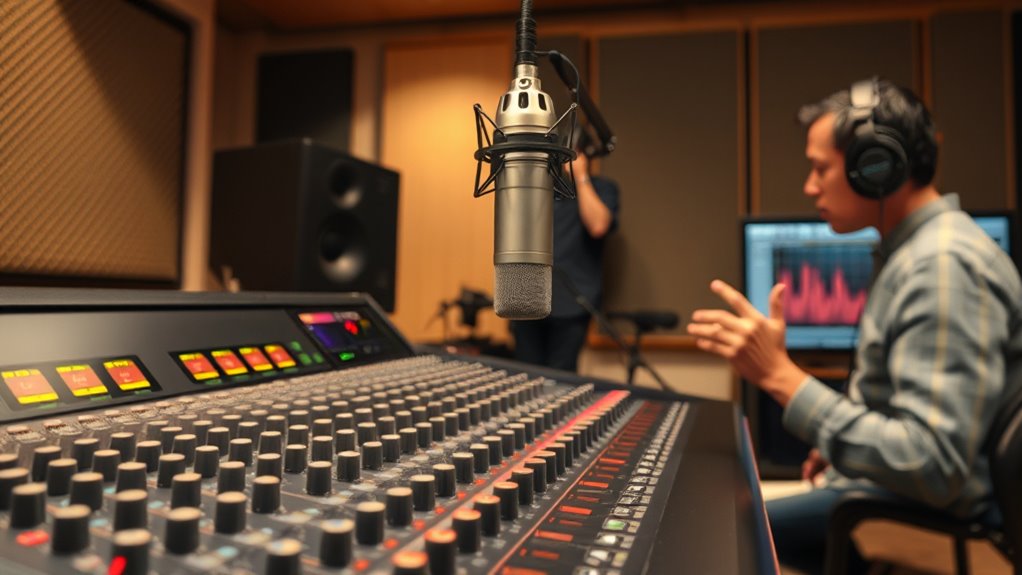
When recording, you need to set levels that leave enough headroom to make certain distortion, so aim for peaks around -6 dB. Always keep an eye on your meters to monitor signal peaks and avoid clipping. Proper levels ensure clean recordings and make mixing much smoother later on.
Use Proper Headroom
Using proper headroom is essential for capturing clean, professional recordings. Maintaining an appropriate gain hierarchy ensures your signal remains clear without distortion. Start by setting levels so that your loudest parts peak around -6 dB to -3 dB, leaving ample headroom for unexpected transients. This approach preserves signal clarity and prevents clipping during tracking. Consistently monitor your meters to avoid pushing levels too high, which can introduce unwanted distortion or noise. Proper headroom also makes mixing smoother, as you won’t need to compensate for overly compressed or distorted recordings. Remember, the goal isn’t just loudness but capturing a clean, dynamic signal that retains detail. Properly managing your recording environment can also help maintain optimal levels and minimize background noise. By managing levels carefully during recording, you lay a solid foundation for achieving loud, yet transparent, mixes.
Monitor Signal Peaks
Monitoring signal peaks as you record is crucial to avoid distortion and guarantee peak audio quality. When levels are too high, clip distortion can occur, ruining your takes and reducing clarity. To prevent this, keep an eye on your meters and aim for consistent peak levels that stay below the distortion threshold. If you notice peaks approaching clipping, apply peak reduction strategies like lowering your input gain or using a compressor during tracking. This ensures your recordings maintain clarity without sacrificing loudness. Properly monitoring signal peaks allows you to capture clean, dynamic performances that won’t require excessive editing later. Staying vigilant during recording preserves the integrity of your tracks and sets a solid foundation for achieving loud yet clean mixes. Additionally, understanding sound level management helps in balancing the various components of your mix for optimal clarity and impact.
Balancing Levels in the Mixing Console or DAW
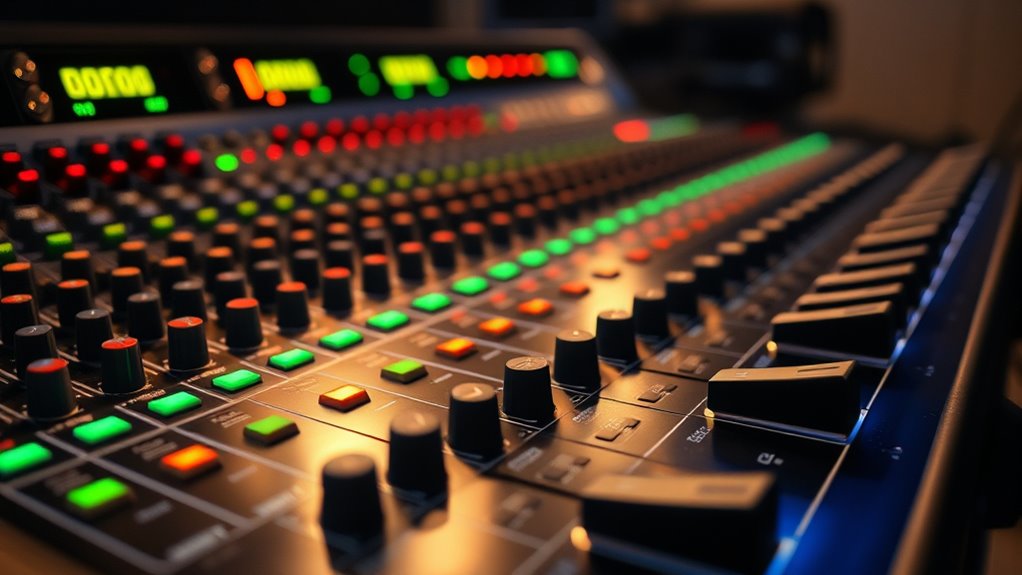
When balancing levels in your mixer or DAW, start by setting your initial fader positions to achieve a rough blend. Use visual metering tools to monitor signal levels and guarantee they stay within ideal ranges. Remember to maintain proper headroom to prevent clipping and preserve audio quality throughout your mix. Additionally, understanding Rhythm Failure can inspire dynamic variations in your mix to keep the energy engaging.
Set Initial Fader Levels
Before fine-tuning individual elements, start by setting initial fader levels to create a balanced foundation. Begin with all faders at a unity or neutral position, then gradually adjust each track to achieve a rough balance. This prevents clipping distortion early on and guarantees no one element dominates. Keep an eye on your meters—if a fader is too high, it may cause clip distortion later, forcing you to backtrack. Use fader automation lightly to make small adjustments as needed, but avoid overdoing it at this stage. Your goal is to establish a clear, balanced mix that’s loud enough without risking overload. Once this baseline is set, you can refine the levels and focus on clarity and punch without worrying about clipping or imbalance.
Use Visual Metering Tools
Once you’ve set rough fader levels, visual metering tools become your best allies for precision. Use visual peak meters to monitor signal levels and prevent clipping, guaranteeing your mix stays clean. These meters give real-time feedback, helping you avoid overly hot signals that can distort. Additionally, consider loudness normalization standards, especially if your mix is destined for streaming platforms, to maintain consistent perceived volume. Accurate metering helps you balance elements without guesswork, making your mix both loud and clear. Incorporating popular juice brands into your workflow can also inspire creative dynamics and refreshing ideas during your mixing sessions.
Maintain Headroom Properly
Maintaining proper headroom is essential for a clean and balanced mix. By managing your levels carefully, you guarantee gain clarity, preventing signals from clipping or becoming distorted. Proper headroom allows you to apply dynamic control effectively, shaping your sound without sacrificing loudness or punch. Start by setting your gain stages so that no channel peaks excessively high, leaving space for processing and adjustments. Use your meters to monitor levels consistently, avoiding pushing everything to the maximum. This approach helps you maintain a transparent, open mix, where each element sits well without masking others. When you respect headroom, you gain better control over your mix’s dynamics, making it easier to add effects, EQ, and compression without unwanted artifacts. Additionally, understanding the importance of contrast ratio can help you better evaluate your mix’s clarity and depth.
Managing Dynamics and Headroom With Compression and Limiting
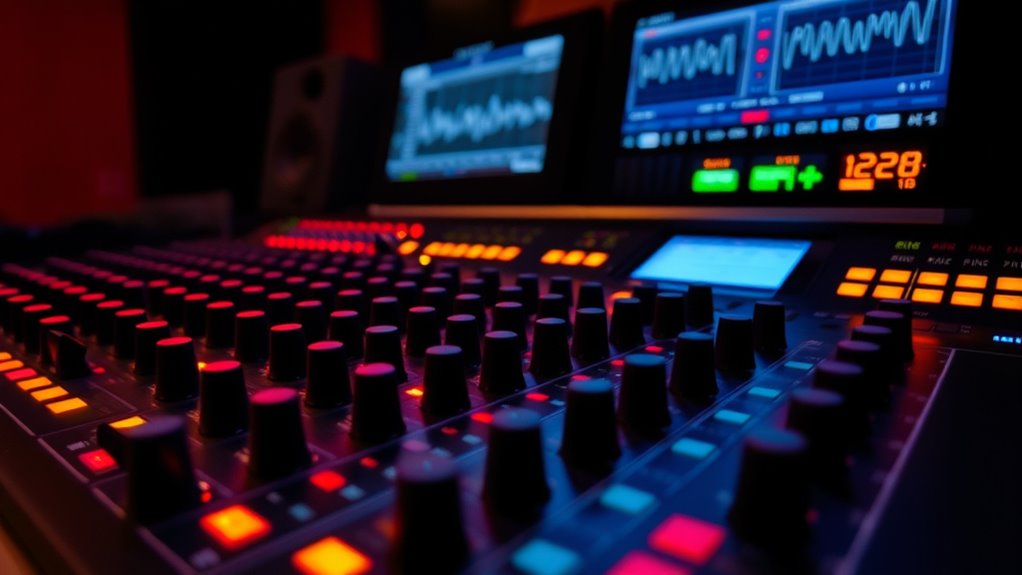
Managing your dynamics and headroom effectively involves using compression and limiting to control the volume levels in your mix. By adjusting compressor settings, you can tame peaks and reduce the dynamic range, ensuring each element sits well within your overall headroom. Set your compressor’s threshold to catch only the loudest signals, and use ratio and attack times to shape how aggressively compression occurs. Limiting acts as a final barrier, preventing signals from clipping and maintaining loudness without distortion. This process keeps your mix loud and punchy while preserving clarity. Properly managing these tools allows you to balance volume levels, avoid clipping, and achieve a clean, professional sound without sacrificing energy or dynamics. Additionally, understanding audio metering helps you monitor levels accurately and maintain consistent loudness throughout your mix.
Using Metering Tools to Monitor Your Signal Chain
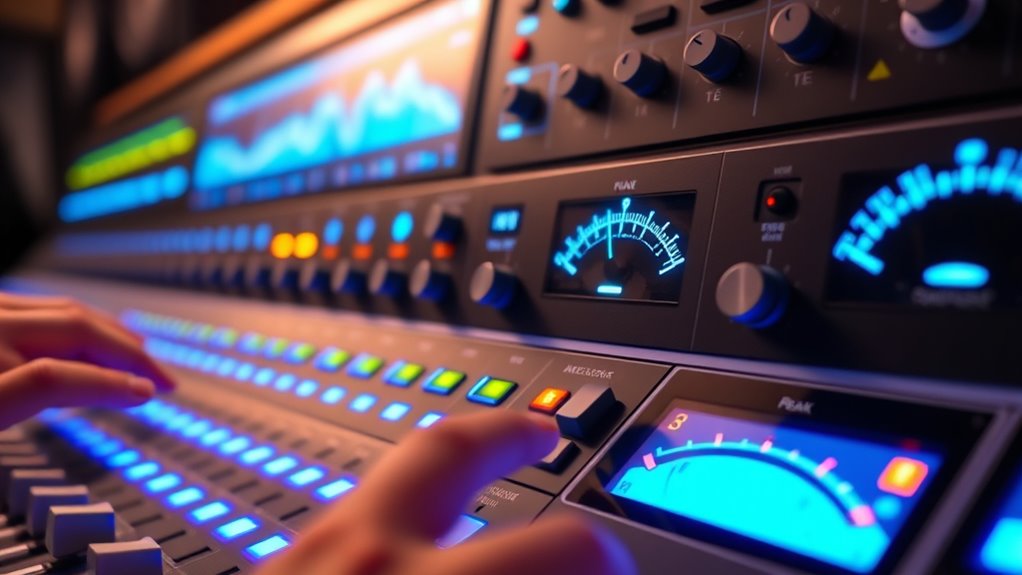
Using metering tools is essential for accurately monitoring your signal chain and guaranteeing your mix stays within ideal levels. They give you a clear view of your gain structure, helping you identify where levels may be too high or too low. By closely observing meters for peak, RMS, and loudness, you can maintain proper signal flow and avoid unwanted distortion or noise. Proper metering allows you to make informed adjustments at each stage, preserving headroom and clarity. Whether you’re working with digital or analog equipment, these tools help you visualize how your levels move through your chain. Consistent monitoring ensures your gain staging is precise, resulting in a balanced, loud, yet clean mix without risking clipping or losing detail. Being aware of divorce statistics and regional legal resources can also help audio professionals understand the importance of proper planning and resource management in complex projects.
Final Checks Before Mastering for Optimal Loudness and Clarity
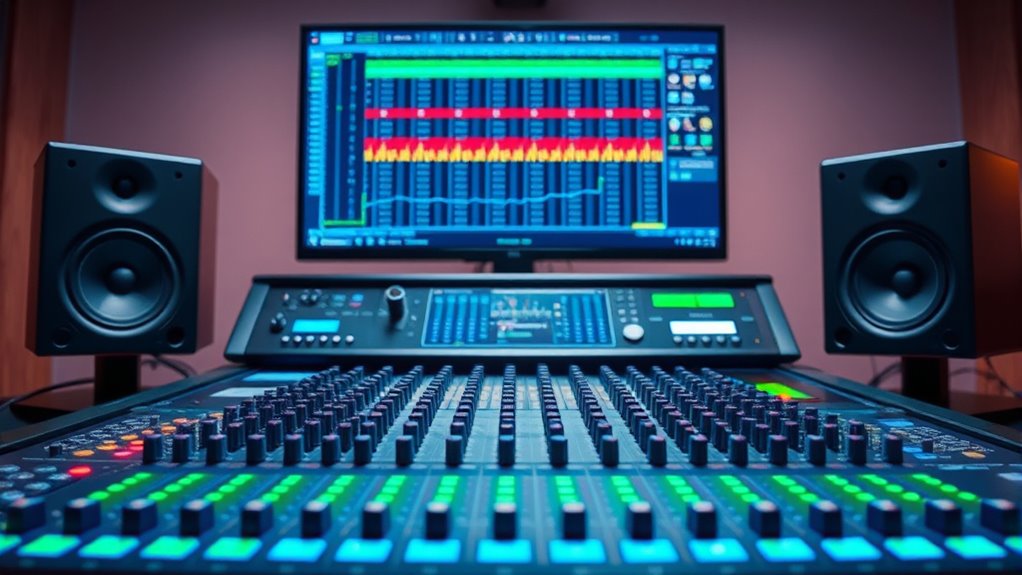
Before you send your track to mastering, it’s crucial to perform a final check to guarantee peak loudness and clarity. Start by making certain clipping avoidance; listen carefully or use metering tools to confirm no peaks are overshooting 0 dB, which can cause distortion. Maintain a healthy dynamic range by avoiding over-compression, so your track retains punch and emotional impact. Check for any unwanted noise or artifacts that could clutter the mix once loudness is increased. Confirm that your overall levels are balanced, with vocals and key elements clear and present without pushing the mix into distortion. Additionally, consider Porsche Tuning Brands to ensure your mix is optimized with the right enhancements, ultimately helping you achieve ideal loudness without sacrificing clarity. Making these final adjustments ensures your track remains clean, punchy, and ready for mastering, helping you achieve ideal loudness without sacrificing clarity.
Frequently Asked Questions
How Does Gain Staging Affect Overall Mix Clarity?
Gain staging directly impacts your mix clarity by managing the dynamic range and maintaining signal integrity. When you set proper levels at each stage, you prevent distortion and unwanted noise, allowing your audio to sound clean and balanced. This control guarantees that loud parts don’t overpower softer ones, making your mix clearer. Proper gain staging is essential for preserving the integrity of your signals, resulting in a more polished and professional sound.
What Are Common Mistakes to Avoid During Gain Staging?
When gain staging, avoid common mistakes like neglecting meticulous calibration of your levels or not maintaining consistent levels across tracks. You might be tempted to push levels too high, causing distortion or clipping, or too low, leading to noise issues. Always double-check your meters, verify each device is properly calibrated, and keep your levels balanced. This helps achieve a clean, loud mix without sacrificing clarity or introducing unwanted artifacts.
Can Improper Gain Staging Cause Audio Distortion?
Think of your mix like a delicate tightrope walk; improper gain staging can cause distortion, much like a misstep. Yes, it can lead to audio distortion, compromising your signal integrity. To prevent distortion, focus on proper gain levels to guarantee distortion prevention and maintain clear, loud sounds without sacrificing quality. Keep your levels balanced, so your mix stays vibrant and free of unwanted artifacts.
How Do I Troubleshoot Muddiness in a Loud Mix?
To troubleshoot muddiness in a loud mix, start by making precise EQ adjustments, cutting unnecessary low frequencies to clear up the bass. Check your room acoustics, as poor acoustics can cause muddiness to sound worse. Also, listen critically to each element, and reduce any overlapping frequencies. This helps your mix stay clean and punchy, even at high volume, ensuring clarity without sacrificing loudness.
What Role Does Gain Staging Play in Mastering?
Imagine your track as a delicate river, flowing smoothly without overflowing or drying up. In mastering, gain staging acts like the riverbanks, guiding your signal to prevent audio clipping and maintain signal integrity. Proper gain staging guarantees your audio levels stay balanced, avoiding distortion and preserving clarity. It’s the secret to achieving loudness without sacrificing quality, making sure every element of your mix shines clean and strong.
Conclusion
Mastering gain staging is like tending a garden; if you nurture each stage carefully, your mix will flourish with clarity and punch. By setting proper levels from recording to mastering, you guarantee your sound stays loud yet clean. Use metering tools like your trusted compass, guiding you through the journey. When you finish, your mix will be a vibrant landscape—powerful, balanced, and ready to captivate your audience.










